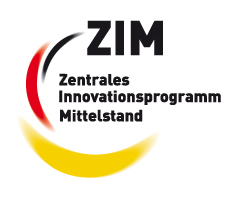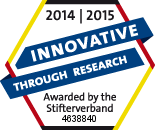Research and Education at Qosmotec
Germany has a fairly good reputation as research location and is famous for its dual education system that combines practical apprenticeships with vocational training. For both areas, Qosmotec is a good example, how research and education are integrated into a company’s workaday life.
There are about 3.5 million enterprises in Germany, but less than one percent of them participate actively in research activities. This figure has been found out by the Stifterverband für die Deutsche Wissenschaft. Qosmotec belongs to this small group and was recently awarded the seal of quality “Innovative through Research” for their contribution to industrial research activities. It is actually surprising that the portion is so small compared to Germany’s standing in the world. “Apart from Chemistry, Pharmacy and Medicine Technology, most research is done at universities and only leaves them, when scientists and academics found spin-offs, because they believe, that they can commercialize their results”, says Qosmotec’s Managing Director Mark Hakim.

The German Ministry of Economics encourages research cooperations of small and medium sized enterprises with universities with public fundings
Research co-operations to improve Qosmotec’s test systems
Qosmotec has gone a completely different way. “We are not an academic spin-off. Our complete management team already had years of experience in other companies, before we started Qosmotec in 2004”. It became soon obvious, how much more could be achieved, if research results and promising ideas would drive the development, rather than just reacting to customer demands. We got in touch with the institute for theoretical information technology at RWTH Aachen University, who do research on signal propagation models. “This was a fantastic add-on to our signal propagation emulator QPER. We found a way to make good use of their research results and integrate them into our simulation software”, explains Mark Hakim the co-operation. In the end it turned out to be a perfect synergy as Qosmotec could took over the part of the practical implementation of research results. For these activities we could make use of public funds that support those kind of co-operations several times. “The number of enterprises, who would like to do some co-operations of this kind is much higher than those, who actively do them. The reason for this is, that research seems too much theoretical on the first glance and people either do not know how or are afraid of the effort to use them practically”.
Dual education guarantees well trained employees and brings input for new products
The tasks that Qosmotec deals with are also challenging enough for writing a bachelor or master thesis. Therefore, Qosmotec is able to offer very attractive apprenticeships for A-level degree students that cannot be found so often in Germany: Our young employees, who become Mathematisch technische Software Entwickler, are educated as application programming engineers by Qosmotec and study in parallel Scientific Programming at the University of Applied Science in Aachen. After three years, they write their Bachelor Thesis in Qosmotec. “We always find a subject which also pushes our test systems”, guarantees Mark Hakim. For example, the test automation app Qosdroid which is now an important application within the LTS platform, has originally been initiated by a such a student project. Since 2008 we have been qualifying six students through an apprenticeship. By now, all of them have become regular employees at Qosmotec. But it is also possible to continue studying in an additional master degree program – for example becoming a master in software engineering.
Next week, in the last article of our jubilee-series, we present a current new research activity in Qosmotec: The development of a signal strength emulator for the upcoming Car-2-Car Communication. This activity combines both aspects mentioned above: It is another research project where the Technical University is involved and it offered enough possibilities for student projects and bachelor thesis’s.





